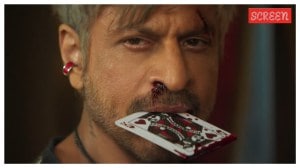Roadside India
There is no better place to behold life’s jamboree than roadside India. With incongruities droll and cruel. Everywhere, the battle to b...

There is no better place to behold life’s jamboree than roadside India. With incongruities droll and cruel. Everywhere, the battle to bob above the water, the rage to carry on, somehow, anyhow. Like the skinny man in rags I saw the other day, deep inside one of those large garbage dumps in Delhi.
The dump was its usual self, an unholy mess spattering on to the street, the dogs, the cows, the occasional pig. This man was not a rag picker. Seated on a low broken stool, a picture of concentration, he was eating food out of a shiny steel plate, heedless of that improbable milieu for a meal, heedless of putrefaction, of flies, roaches and animals. He broke his roti carefully with lean fingers, wrapped the morsel in a bit of aloo and placed it with great deliberation in his mouth. People passed by, no one stopped to stare.
In Pune, I walked down one of the city’s major avenues. Broad and serene it once was. That’s a poor joke now. Jangli Maharaj Road, once the pride of the city, is today a victim of the usual municipal scramble to dig, and the citizens’ scramble to park and encroach, a sad shadow of its once graceful self. And there, on a pavement turned inside out, amidst a turbulence of wires, pipes, bricks and what have you, lay a gaunt beggar on a mat. In the unlikely space between two awesome holes. Next to him, a small brown tin for the coins to drop, under his head, a grey bundle of clothes rolled into a pillow. Long unwashed hair, matted beard, claws for nails. And then, in his hands, that morning’s edition of Sakal, the popular daily, which he, like his self-absorbed confrere in the dump, was reading with a proof reader’s application. He read, I stared. His eyes travelled down a story and he turned the paper to page 5 to read it to the end. No one stopped to look.
And the poor leper woman on Pune’s Main Street. She was begging in the fifties, in the sixties, in the seventies and eighties and nineties. Short, squat, and always dressed in white. In the early years, her fingers gave strong hints of the disease. In the sixties, the sickness had reached her face. Her mouth began to sag to the right, even as her fingers and toes grew shorter. In the eighties, so insanely twisted was her visage, her mouth seemed to reach her ear, and the toes had dissolved into stubbles. In the nineties, her eyes had caved in, and her face was quite simply devoid of any feature. Sans mouth, sans nose, sans eyes, sans chin. Gone were the fingers, gone were the toes. Yet she lived and begged, just a part of that roving humanity, naturally merging in our landscape of the lame, maimed, diseased. No one stared. Not then, not now.
And, nearby, a handsome, well-proportioned he-goat, smart horns, sturdy legs, motionless. On his back, a crow, head cocked, watched the goat’s neck intently. And every now and then, he would give a sharp peck. With every peck, he picked mites from the goat’s neck. A true scavenger, he. The goat was a picture of patience, the crow a picture of diligence. No one stared.
- 01
- 02
- 03
- 04
- 05





























